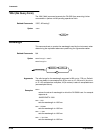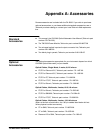
Status and Events
OA 5000 Series User Manual
3 --- 41
Tables 3-10 through 3-15 list all the programming interface messages the
OA 5000 generates in response to commands and queries.
For most messages, a secondary message from the OA 5000 gives more
detail about the cause of the error or the meaning of the message. This
message is part of the message string, and is separated from the main
message by a semicolon.
Each message is the result of an event. Each type of event sets a specific bit
in the SESR, and is controlled by the equivalent bit in the DESER. Thus,
each message is associated with a specific SESR bit. In the message tables
that follow, the associated SESR bit is specified in the table title, with excep-
tions noted with the error message text.
Table 3-10 shows the messages when the system has no events or status to
report. These have no associated SESR bit.
Table 3-10: No Event Messages
Code
Message
0 No events to report --- queue empty
1 No events to report --- new events pending *ESR?
Table 3-11 shows the error messages generated by improper command
syntax. Check that the command is properly formed and that it follows the
rules in the Command Syntax chapter starting on page 3---5.
Table 3-11: Command Error Messa ges — CME Bit 5
Code
Message
100 Command error
101 Invalid character
102 Syntax error
103 Invalid message or unit separator
104 Data type error
105 GET not allowed
106 Invalid program data separator
108 Parameter not allowed
109 Missing parameter
110 Command header error
111 Header separator error
112 Program mnemonic too long
Messages


















